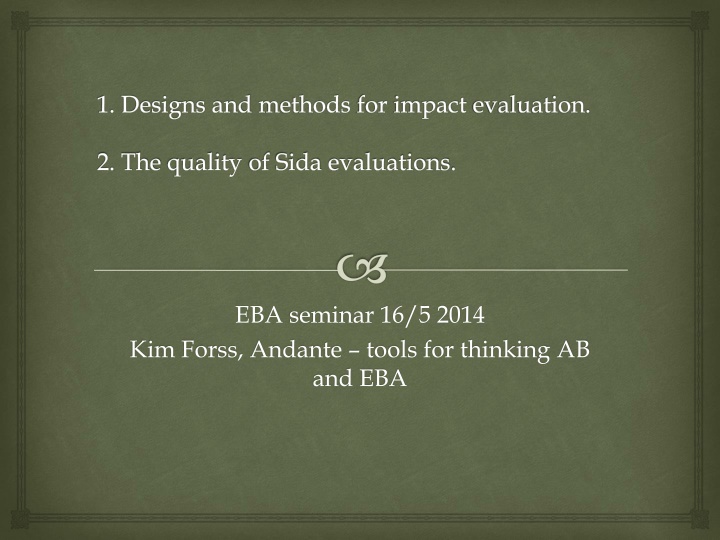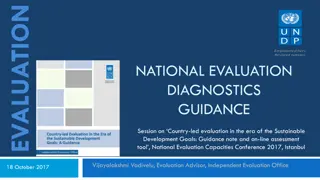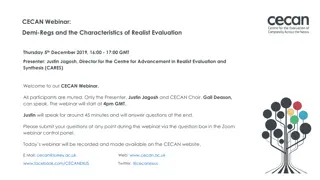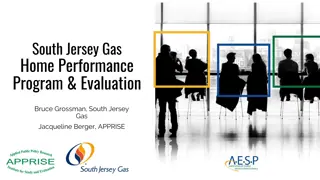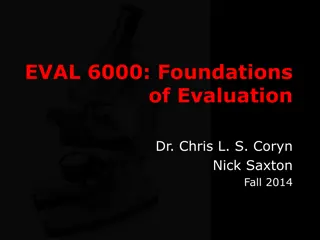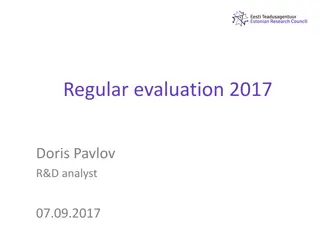Enhancing Impact Evaluation Methods: A Comprehensive Approach
Explores diverse designs and methods for impact evaluations, emphasizing the importance of assessing intervention effectiveness and understanding causal relationships. Discusses specific evaluation tasks and essential questions to determine impact attribution and intervention success, along with challenges in evaluation practice. Also delves into the significance of understanding causality, unintended impacts, and scalability of interventions for sustainable outcomes.
Download Presentation

Please find below an Image/Link to download the presentation.
The content on the website is provided AS IS for your information and personal use only. It may not be sold, licensed, or shared on other websites without obtaining consent from the author.If you encounter any issues during the download, it is possible that the publisher has removed the file from their server.
You are allowed to download the files provided on this website for personal or commercial use, subject to the condition that they are used lawfully. All files are the property of their respective owners.
The content on the website is provided AS IS for your information and personal use only. It may not be sold, licensed, or shared on other websites without obtaining consent from the author.
E N D
Presentation Transcript
1. Designs and methods for impact evaluation. 2. The quality of Sida evaluations. EBA seminar 16/5 2014 Kim Forss, Andante tools for thinking AB and EBA
1. Broadening the range of designs and methods for impact evaluations DFID Working Paper 38, 2012 Elliot Stern (team leader), Nicoletta Stame, John Mayne, Kim Forss, Rick Davies, Barbara Befani. www.gov.uk Background - policy on evidence-based decision- making Does scientific rigour and evidence equal experimental methods? Challenges in evaluation practice
Examples of evaluation tasks Strategic Climate Institutions Programme in Ethiopia District Development Programme in Afghanistan Violence against Women, Bihar, India Civil Society Governance Fund, Malawi Response to Haiti Earthquake Results Based Aid in the Education Sector in Ethiopia
Nailing down the impact evaluation questions To what extent can a specific impact be attributed to the intervention? Did the intervention make a difference? How has the intervention made a difference? Will the intervention work elsewhere?
Understanding causality when can an event be said to cause an effect Both necessary and sufficient Necessary but not sufficient Sufficient but not necessary Neither necessary nor sufficient but a contributory cause The notion of causal packages
Understanding how an intervention makes a difference How and why have the observed impacts come about? What causal factors or mechanisms in what combination have resulted in the observed impacts? Has the intervention resulted in any unintended impacts, and if so, how? For whom has the intervention made a difference?
Will the intervention work elsewhere? Can this pilot be transferred elsewhere and scaled up? Is the intervention sustainable? What generalisable lessons have we learned about impact? Or, if the hoped for impacts are not being realized we want to know, Why have the impacts not been realized? What contribution has the intervention made? Were the impacts not realized because of programme failure or implementation failure? :
Distinctions Distinguishing designs and methods Design refers to the overarching logic of how research is conducted and consists of four elements: research questions,theory, data and the use of data. Different designs may share similar methods and techniques Distinguishing evaluation and research Impact evaluation is inevitably pushed towards the norms and principles of scientific research
Design approaches (1) Approaches Specific variants Basis for causal inference Experimental RCTs and other true experiments Quasi experiments Natural experiments Statistical modelling Longitudinal studies Econometrics Counterfactual logic Statistical Correlation between cause and effect or between variables, influence of (usually) isolatable multiple causes on a single effect Identification/confirmation of causal processes or chains Theory-based Causal process designs: Theory of Change, Process tracing, Contribution Analysis, impact mapping Causal mechanism designs: Realist evaluation, Congruence analysis Supporting factors and mechanisms at work in context
Design approaches (2) Design approaches Case based approaches Specific variants Basis for causal inference Interpretative: Naturalistic, Grounded theory, Ethnography Structured: Configurations, QCA, Within-Case- Analysis, Simulations and network analysis Participatory or democratic evaluation, Empowerment evaluation Comparison across and within cases of combinations of causal factors. Analytic generalisation based on theory. Validation by participants that their actions and experienced effects are caused by programme Accumulation and aggregation within a number of perspectives (statistical, theory based, ethnographic etc.) Participatory approaches Synthesis studies Meta analysis, Narrative synthesis, Realist based synthesis
Which approach to choose? Requirements Potential strengths Potential weaknesses Experimental Two identical cases for comparison, ability to control the intervention Avoiding bias Generalisation Role of context Statistical Many/diverse cases, independent causes Uncovering laws Difficult explaining how and why . Construct validity Theory and/or case based/multiple causation Sufficient number of cases. Availability of cases with comparable characteristics. Discovery of typologies. Dealing with limited complexity. Difficulties interpreting highly complex combinations. Theory and/or case- based/generati ve mechanisms One case with good access to multiple data sources. Theory to identify supporting factors . In-depth understanding. Focus on the role of contexts. Fine-grained explanation. Estimating extent. Risks of bias/ loss of evaluators independence.
Concluding remarks IE must fit with contemporary development architecture that is decentralised, works through partnership and where developing countries are expected to be in the lead - practical implications for example, working through partners leads to multi-stage, indirect causal chains that IE has to analyse. Most interventions are contributory causes . They work as part of a causal package in combination with other helping factors such as stakeholder behaviour, related programmes and policies, institutional capacities, cultural factors or socio- economic trends. Designs and methods for IE need to be able to unpick these causal packages. IEs should not be regarded as an everyday commission. Any IE that is thorough and rigorous will be costly in terms of time and money and will have to be justified.
2. The quality of Sida evaluations Mid Term Review of the Framework Agreement for Sida Reviews, Evaluations and Advisory Services on Results Frameworks. Transtec. LaGuardia, D. et al (2013) Are Sida Evaluations Good Enough? Sida studies in Evaluation 2008:1. Forss, K. et al. The Quest for Quality - or can evaluation findings be trusted? Evaluation, Vol (4), 481 502. Forss, K. and Carlsson, J. (1997) N gra aspekter p kvaliteten inom utv rderingar av svenskt bist ndssamarbete. Genomg ng av databas uppr ttad vid Sekretariatet f r Analys av Utvecklingssamarbete. En rapport best lld av Sekretariatet f r Analys av Utvecklingssamarbete. Forss, K. (1994)
Coverage 1994: 177 evaluations between 1969 and 1994 1997: 277 evaluations between 1969 and 1996 2008: 34 evaluations between 2002 and 2005 2013: 80 reports between 2011 and 2013(?)
What defines evaluation quality? Utility Feasibility Propriety Accuracy The Program Evaluation Standards. Joint Committee on Standards. Sage (1994)
Choice of evaluation design 1994 Evaluation design 1997 2008 2013 Experimental Statistical Theory-based Case-based Participatory Synthesis - - 9% - 1% - - - 33% - - -
Conclusions on choice of design Choice of design does not immediately reflect poor quality of an individual evaluation In a system where many evaluations are commissioned you would expect a variety of designs Impact is often only one of many questions in ToR and hence design for impact analysis does not drive the evaluation effort Very low awareness of the choice of design. Evaluation methods are primarily discussed in terms of data collection (interviews, surveys, etc.)
Aggregated rating 1994 - - - Excellent Adequate Poor 10 76 31 6% 45% 18% Not possible to assess - 52 31% Sum 169 100
Aggregated rating 2008 Rating interval Description Number of evaluations 0 Percentage of total 26 30 Excellent in respect of several quality aspects and very good in the others (Very good) Good in respect of many quality aspects, and satisfactory in respect of others (Good) Adequate, but not quite satisfactory, some shortcomings in essential aspects of quality ( Medium) Significant shortcomings in some respects and some shortcomings in most of the other (Poor) Significant shortcomings in all aspects of quality (Very poor) 0 21 25 11 37% 16 - 20 12 40% 11 15 6 20% 6 10 1 3%
Aggregated rating 2013 Average (Last 12 Months) Average (TOTAL) Rankings ALL REPORTS ALL (80 Reports) Aug '12 - Jul '13 (41 Reports) Terms of Reference 3.96 4.08 6 Excellent Evaluation Questions 4.19 4.38 5 Adequate Methodologies 4.28 4.48 4 Minimally adequate Data Collection 4.39 4.45 3 not quite adequate Data Analysis/Analytical Content 4.18 4.26 2 significant problems Conclusions & Recommendations 4.48 4.57 1 very poor Reporting 4.75 4.80 Data Analysis/Analytical Content, Conclusions & Recommendations, and Reporting Average 4.41 4.54 Total Components Average 4.31 4.41
Concluding remarks The quality might be slowly increasing Fewer really poor evaluations Fewer really excellent evaluations (?) Still much confusion about what constitutes quality The assessments though extensive focus on some few aspects of quality Ethics and Feasibility are the aspects of quality that have been largely neglected The question of design for impact assessment has not been properly analysed in the quoted studies
